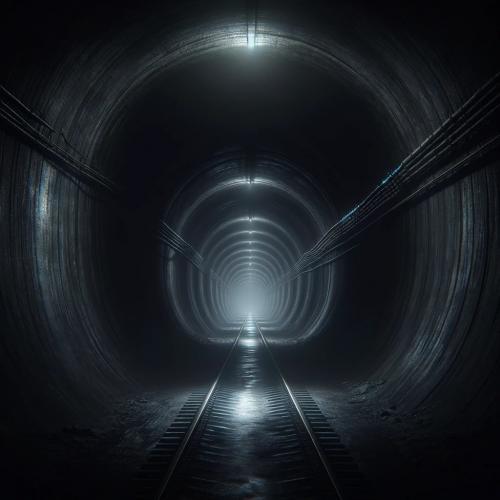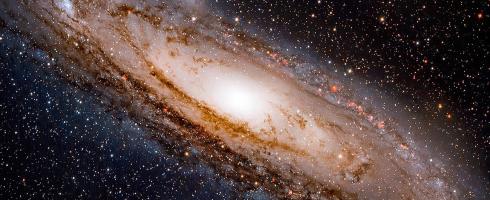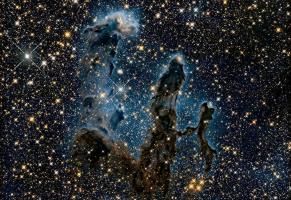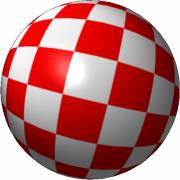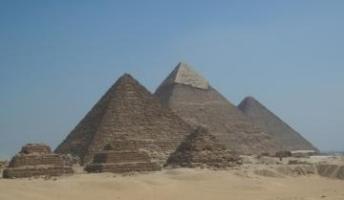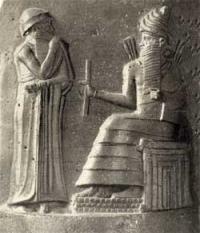Meteor and falling stars
How many of us in the warm August nights have not looked up to the sky, perhaps equipping themselves with a deckchair and binoculars to hunt for falling stars? Who does not know the classic night of Saint Lorenzo, when a sudden luminous trail in the sky allows us to make a wish with the hope of seeing it becoming true?
This phenomenon, which has so intrigued or even frightened humanity over the centuries, although called "falling stars", has very little to do with the stars that illuminate the cosmos, but it is only minute fragments of dark material that penetrating in the earth's atmosphere overheat and disintegrate due to friction (a body attracted by the force of earth's gravity falls with an acceleration of 9.82 meters per second squared, that is, every second it increases its speed by about another ten meters, until a constant speed is reached due to frictional forces).
According to this physics law, which is part of the universal gravitation law formulated by Isaac Newton long time ago, the spectacular trail of light on the black background of the night sky that we observe is a phenomenon that occurs at an altitude between 40 Km and 150 Km. But it was the astronomer Giovanni Virgilio Schiapparelli to give the first convincing explanation: the Earth, rotating on the plane of the ecliptic (i.e. that imaginary plane that it travels in its annual movement around the Sun), periodically comes into contact with swarms of wandering particles composed of fragments of rock and others frozen materials and attracts them through its gravitational force.
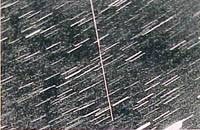
It is the deceptive effect of the perspective that makes us seem in the August nights that these meteors or falling stars come from the Perseus constellation behind them, and for this reason they are called Perseids. In reality, the constellations are composed of stars far from each other, millions of light years away from us, and have nothing to do with this phenomenon as well as absolutely nothing with the ravings of astrology. In reality, however, the Earth attracts towards itself every day (and not just at night) small or large meteors.
Usually these fragments are almost entirely of such size that they cannot reach the surface of our planet because friction consumes them completely, thus adding to the natural atmospheric dust. However large sized bodies can reach the ground and then it is legitimate to speak of meteorites, solid objects usually stony (aeroliths) or metallic
(holosiderites).
To get an idea, it has been calculated that every 24 hours, 14 million meteors fall for a total mass of 5 tons into our planet. A trifle, which, however, contributes to "burdening and increasing" the planetary body on which we live: in practice, the formation of the solar system can still be said not to be completed.

The table below will allow you to have a more complete picture of the phenomenon, that is, with how many falling stars we are dealing with, every yea.
| Annual falling stars | |||
| phenomenon | average duration in days | period | average number of meteors / hour |
| Age Aquarids | 15 | July 30 | 10 |
| Perseids | 10 | August 12 | 40 |
| Andromeda | 10 | November 22 | 1 |
| Orionids | 8 | October 20 | 12 |
| Geminids | 6 | December 13 | 50 |
| Leonidi | 5 | November 16 | 10 |
| Delta Acquaridi | 4 | May 4 | 5 |
| Lyidi | 3 | April 21 | 5 |
| Quadrantids | 1 | January 3 | 30 |
| Ursidi | 1 | December 22 | 10 |
| Draconidi | 1 | October 9 | 5 |
The Eta Aquarids, visible at the end of July, are those that last the longest, but fall with an amount that is only one fifth of the Geminids, visible in mid-December. However, the duration of these is only 6 days compared to 10 of the Perseids (mid August) and the Andromedids (second half of November). And the latter, however, are the least abundant (one per hour) and therefore the most disappointing. From this brief analysis it is easy to understand how, due to the favorable parameters (quantity, duration and good season) the Perseids or "tears of Saint Lorenzo" are at the top of the ranking among the most known and observed meteors.
Recall that the last evident appearance of the Leonids was for November 2002. The next visible appointment will only be in thirty years, or between 2029 and 2033.
METEORITES AND ASTEROIDS
We have said that some large meteors manage to reach the surface of our planet despite the protective shield offered to us by the atmosphere, and are called meteorites.
Wandering asteroids are also meteorites whose orbit can dangerously cross that of the Earth until they are captured by its gravitational field. Most of them are scattered fragments at the time of the formation of the solar system, currently residing in three different belts: that between Mars and Jupiter, the Kuiper Belt beyond the orbit of Neptune, and the Oort cloud, at two million light years away from us, roughly halfway between the Sun and the nearest star. On average, about 40 or 50 meteorites are found each year, but in reality several hundred of them arrive on Earth, which fall into the sea or in uninhabited areas where they are destroyed by atmospheric agents. It is estimated that there are at least one million objects in our Solar System that exceed the threshold of penetration through the Earth's atmosphere, namely 50 meters in diameter, which would prevent them from completely burning from friction. A thousand, on the other hand, are between 1 Km and 20 Km in diameter, enough to cause catastrophes on a planetary level (it should not be forgotten that most of these rocks travel at a speed of 20 or 30 Km per second).
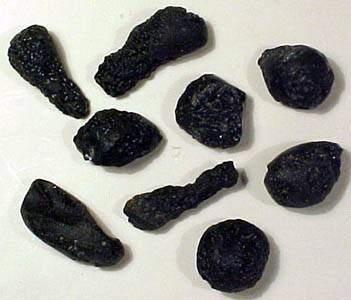
All meteorites can be classified into three groups, depending on the percentage of their main geological components. Then there are the siderites (or meteoric irons) which are essentially composed of an iron-nickel alloy. The mesosiderites, which contain both nickel-iron and some minerals called silicates. Finally, aeroliths (or meteoric stones) composed mainly of silicates, and in particular pyroxene and olivine, together with plagioclase and traces of nickel-iron.
Meteorites can also be classified by their morphological structure, and are then called chondrites if they contain small spheroidal concretions called "chondrules", otherwise achondrites if they are lacking it (but are only a small percentage). The most interesting aerolites are the carbonaceous chondrites, containing a high percentage of carbon: it is believed that they are the oldest existing rocks, which have remained practically unchanged since the formation of the solar system.
To recognize a meteorite, you must first carefully observe its structure. The most noticeable element is the melting crust, a thin black film often found on only one side of the meteorite, and is caused by the intense overheating caused as it penetrated the Earth's atmosphere.
A particular type of meteorite are the tektites. They are glassy stones that are often found concentrated in certain places on Earth, and so they take their name from the places where they were found. Those of Bohemia and Moravia are called Moldavites; those of southern Australia Australians; of the south-east of the USA Bediasites and those of Georgia are the tektites, from which the whole group takes its name. About 4/5 of the known tektites in the broad sense come from the Philippines and are called Filipinos.
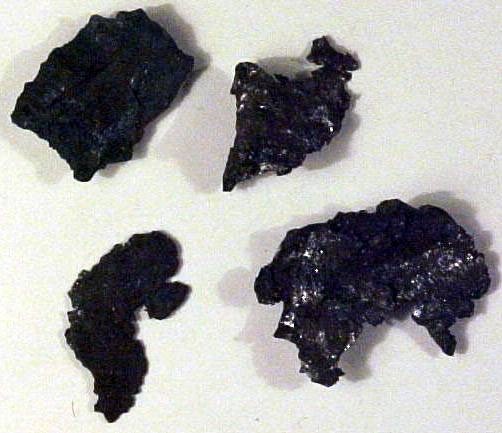
Tektites were once thought to be meteorites - a meteoric glass coming exclusively from the depths of space. Today it is thought that it is more likely a type of impactite, produced in craters formed following the interaction of a meteorite with the earth's crust. Many of them are pitted, others have an elongated shape due to the liquefied state following the high temperatures to which they are subjected, which melts the rocks involved. They generally have sizes of the order of 1 to 3 cm, but some are even larger. They are mostly black and rich in iron, aluminum, calcium and potassium.
The largest meteorites found are the siderites. A huge one was found in Namibia, weighing about 60 tons. It must have fallen to Earth not very violently in a trajectory that did not make it crater or disintegrate. The largest stony meteorite has a mass of almost 1800 kg and is part of a group of meteorites that fell in China in 1976.
Even the Moon was not spared by meteorites: the moon suffered an intense bombardment about 4 billion years ago, causing lava similar to our basaltic magma to escape from the bottom of the then existing magma basins, after which it is assumed that the Moon is "dead", or has exhausted all its endogenous activities. In fact, most of the lunar dust contains glassy spheres, residues of fragments probably due to the impact of ancestral meteorites.
The most recent cosmic impact of planetary flows ever observed kept the world in suspense between July 16 and 22, 1994, when the fragments of the comet Shoemaker-Levy fell on Jupiter, affecting areas up to a diameter of 2,500 Km, and raising dust for 1,600 Km above the atmosphere of Jupiter (and keep in mind that the gravity of Jupiter is much greater than ours), spreading them over an area with a diameter of 12,000 Km, almost like our equator. The energy developed was estimated to be around 6 million megatons, one hundred thousand times greater than the most powerful nuclear bomb ever exploded on Earth.
The largest meteoric crater still visible on Earth (the forces of erosion over time smooth them out, which for example did not happen on the Moon, devoid of water and atmosphere, the main agents that cause erosion) is the Meteor Crater in Arizona (which would be more correct to call Meteorite Crater), with a diameter of 1,200 meters and a depth of 180 meters. It was caused about 25,000 years ago by a meteorite whose weight has been estimated at 250,000 tons. Most of the meteorite was destroyed in the impact, but enough fragments remain scattered around the crater to show that the meteorite was a ferrous type.
On June 30, 1908, an explosion devastated an area (fortunately deserted) of the Siberian region of Tunguska, for a radius of 30 Km, without leaving a crater. The explosion occurred at an altitude of 8 km and released energy equivalent to 10 or 20 million tons of TNT. It is believed that this object, no larger than 30 meters in diameter, was a fragment of the head of Encke's comet, a "delicate mixture" of frozen dust and gas. Therefore, due to its low density, it was completely destroyed before it could reach the surface of our planet and generate a crater.

Another famous meteorite is the one that seems to have contributed to the Great Extinction that marked the end of the Mesozoic and many of the life forms then existing, such as dinosaurs. When Luis Alvarez expounded his theory regarding the iridium layer of meteoric origin deposited in Gubbio and other places on Earth, scholars received it with skepticism because the fall of a body as large as Alvarez hypothesized should have caused a crater of about 200 Km in diameter. And the largest known then were Sudbury Crater (Canada) and Vredefort Crater, South Africa, both 140 km in diameter.
But in 1991 the Chicxulub crater was discovered in the Yucatan (Mexico), buried under a kilometer of sediment: it has a main diameter of 180 km, but its outermost rings touch a diameter of 400 Km. To produce it, 65 million of years ago, it is estimated that it must have been an asteroid with a diameter of at least 10 km that crossed the atmosphere at a speed of 40 Km per second, raising twenty trillion tons of water on impact with the seabed and just as much rock material pulverized by an explosion equal to one billion megatons of TNT, unimaginable even by comparing it with current nuclear bombs.

The impact, in that particular area rich in limestone, freed so much of that nitrogen and carbon that, when combined with other elements, produced copious acid rain and an impressive greenhouse effect. After a long period of very high temperatures, a real nuclear winter followed, due to the dust clouds that remained suspended in the atmosphere, which interrupted photosynthesis by destroying entire food chains and millions of living species disappeared forever from the face of the Earth. Only the smallest and most opportunistic animal species survived (with some exceptions, such as sharks and crocodiles) and plants with very resistant spores. For those who consider such a darkening unlikely, just think that the most violent volcanic eruptions, of a much more modest entity, have been observed to be capable of producing a very similar phenomenon. Recent discoveries hypothesize the fall, also at that time, of another gigantic meteorite, albeit of much more modest dimensions; who knows, perhaps the result of a periodic rain of cosmic giants of which we have no knowledge.
The crater, nicknamed Silverpit Crater, is more than 3 Km in diameter and 300 meters deep and is located in the North Sea 130 Km east of the British Yorkshire coast. The impact of the space body generated an explosion 50,000 times more powerful than the Hiroshima bomb.
Although asteroids over 10 Km in diameter would fall on average one every 100 million years, it is currently believed that in a century the Earth has a probability in ten thousand of being impacted by a large asteroid, or that each of we are more likely to die from a meteorite than from a tornado.
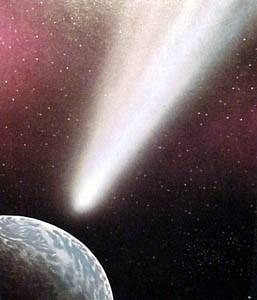
In 1994, on the Sicilian island of Vulcano, dozens of experts in planetary sciences, responsible for the major research centers in the world, met to define a common strategy of action and prevent the impact of any asteroids and comets on our planet.
It turned out that with a negligible investment, if compared to the resources invested in the military field, it would be possible in about twenty years to organize a valid defense plan.
The main problem was the effectiveness of any nuclear warheads on objects of gigantic mass and made of metallic material such as nickel-iron. Computer simulations have shown that the result would only be to fragment 10 % to 50% of the total mass of the asteroid, thereby producing smaller but equally dangerous, and more radioactive, splinters.
Yet the solution is simpler than you think. If disintegrating or just deflecting such an object while pointing at us is very difficult, deflecting it by hitting it from the side, at an angle of 90 ° with respect to its trajectory is more achievable. This is the idea proposed by Claudio Maccone, of the International Astronautics Academy.
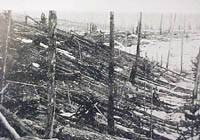
It would be enough to place batteries of missiles approximately in the Lagrangian point, that is where the gravitational forces of the Earth-Moon system are balanced, and these would be in the ideal conditions to act at any time and with the minimum effort.
In fact, it is not the power of the explosion that is important, but the thrust that the missile is able to impart to the asteroid, since it is enough to deflect the body without fragmenting it.
For this, against asteroids smaller than 1 Km, even missiles without nuclear warheads may be sufficient.
All that remains is to convince governments to finance such a project, perhaps more important than even going to Mars before solving our problems of overcrowding and pollution here on Earth.











